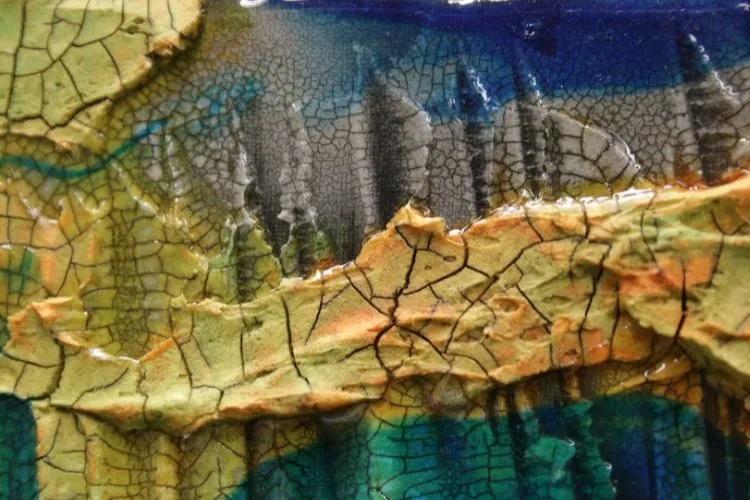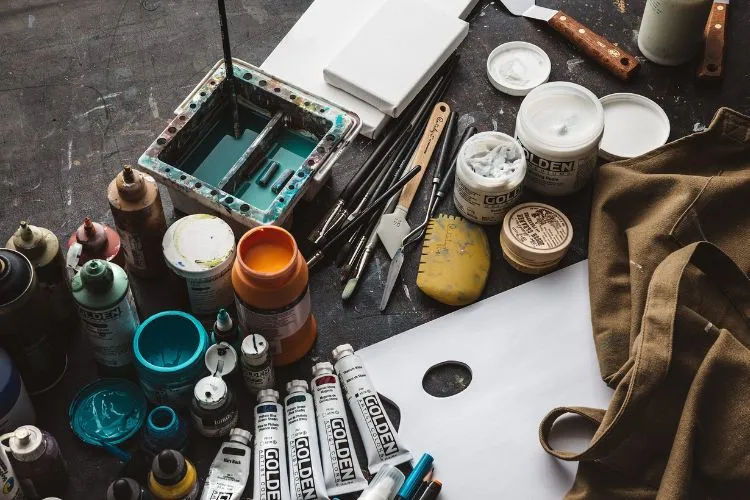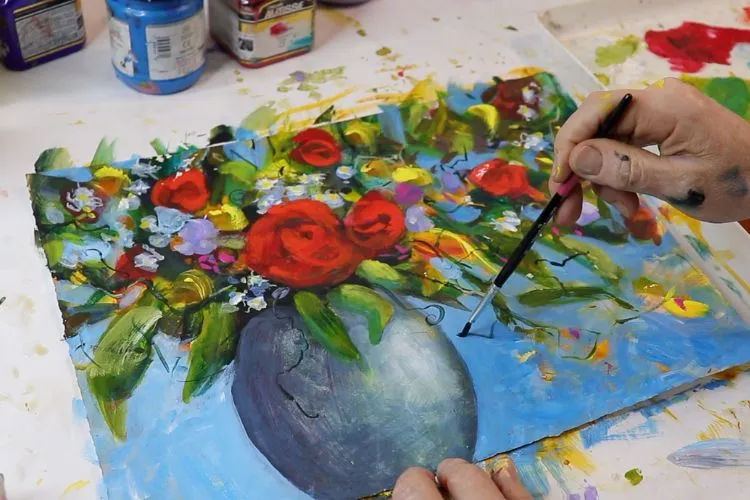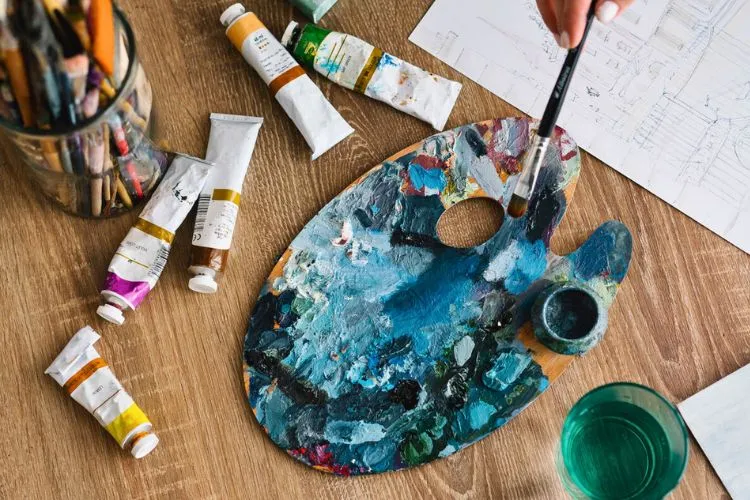Acrylic paintings beautify many spaces with bold colors and breathtaking scenery. However, over time, these pieces may develop cracks due to various factors.
If left unattended, these fissures can worsen, detracting from the artwork’s beauty and value. Thus, understanding the causes and learning how to address them timely is crucial.
This article delves into how to fix cracked acrylic painting, ensuring they remain vibrant for years to come.

Understanding Acrylic Paint Cracks
Types of Cracks
Cracks in acrylic paintings can vary. Hairline cracks are thin and superficial, deep cracks penetrate through layers of paint, and structural cracks involve both the paint and the canvas. Recognizing the type of crack is the first step in determining the appropriate repair method.
Causes of Cracking
Several reasons contribute to the cracking of acrylic paintings. Rapid drying can cause the paint to contract quickly, leading to hairline cracks.
The quality of acrylic paint also plays a role; lower-grade paints might not have the flexibility or adhesive properties of their high-quality counterparts.
Additionally, issues with the canvas, like inadequate stretching or priming, can lead to structural cracks. Finally, environmental factors such as humidity and temperature fluctuations can cause or exacerbate cracking issues.
Preventative Measures
Choosing the right materials and preparing them properly can prevent many issues. High-quality paints, properly prepared canvases, and controlled painting conditions can significantly reduce the risk of cracking.
Materials Needed
Before beginning repairs, gather the necessary tools and materials. These may include a palette knife, acrylic polymer or medium, and varnish.
Selecting the right type of acrylic medium is crucial, as it must match the painting’s original finish. Safety precautions, like working in a well-ventilated area, are also essential.

How to Fix Cracked Acrylic Painting?
Preliminary Steps
Start by cleaning the painting’s surface gently. Then, closely examine the extent of the damage to decide on the best repair approach.
For Hairline Cracks
Small, superficial cracks often require stabilizing the paint layer. Filling these cracks with an acrylic medium or paint that matches the original colors can effectively hide them. Ensure the filler dries completely before proceeding.
For Deeper Cracks
Deeper cracks might need a mixture of paint and filling medium, applied with a palette knife. This process requires patience, as the filler must dry thoroughly. In some cases, applying the mixture in layers may be necessary to achieve a level surface.
For Structural Cracks
These involve more complex repairs, addressing both the paint and canvas. Sometimes, applying a patching compound to the canvas and then repainting the affected area is necessary. Techniques for blending this repaired area with the surroundings are essential for a seamless finish.
Other Guide: How to Make Acrylic Paint Dry Faster? Techniques and Tips
Finishing Touches
After repairing the cracks, sanding and smoothing the area ensures the surface is even. Then, applying a varnish can protect the painting and give it a uniform finish.
This step might require matching the varnish’s gloss or matte quality with the original painting.

Aftercare and Prevention
Maintaining acrylic paintings involves regular dusting and avoiding extreme temperatures or humidity.
Regular inspections can help catch new cracks early, making repairs easier. Environmental controls, like air humidifiers or conditioners, can also protect the artwork.
Pro Tips
When repairing a cracked acrylic painting, flexibility is key. Choose repair materials that offer similar flexibility to the original paint to ensure the repair lasts.
Also, consider testing the repair technique on a smaller scale or inconspicuous area first to ensure it provides the desired results.
Common Mistakes to Avoid
When repairing cracks in acrylic paintings, it’s important to be aware of the following common mistakes to ensure a successful restoration:

- Incorrect Medium: Using a medium that is not compatible with acrylic paint can lead to further cracking or peeling. Always use an acrylic polymer medium or gel designed for art restoration.
- Excessive Pressure: Applying too much pressure with a palette knife can cause additional damage to the painting. Use gentle strokes to apply the filling material.
- Ignoring Manufacturer Instructions: Not following the product instructions for the medium or varnish can result in improper consistency or finish. Take the time to read and understand the guidelines.
- Rushing the Process: Allowing insufficient drying time between layers or before applying varnish can compromise the repair. Be patient and wait for each layer to cure completely.
- Skimping on Preparation: Neglecting to properly clean and prep the painting surface before beginning repairs can prevent the filler from adhering correctly.
Avoiding these pitfalls will help maintain the integrity of the painting and ensure the longevity of the repair work.
Frequently Asked Questions (FAQs)
Can I use regular glue to repair cracks in an acrylic painting?
Using regular glue is not recommended, as it may not offer the same flexibility or finish as acrylic mediums designed for this purpose.
Why do small cracks still appear even after proper application and drying?
Several factors, including environmental conditions or deeper structural issues, can cause new cracks. It’s important to address underlying issues to prevent recurrence.
Are DIY repair methods sufficient for large or antique acrylic paintings?
While DIY methods can fix minor issues, large or valuable paintings should be entrusted to professional conservators to ensure the integrity of the artwork.
How long should I wait after repairing a crack before applying varnish?
Wait until the repair completely dries, which could take up to 24 hours or longer, depending on thickness and humidity.
Does room temperature affect the repair process of a cracked acrylic painting?
Yes, extreme temperatures can affect drying times and the effectiveness of the repair. Work in a stable, controlled environment for the best results.
Conclusion:
Cracks in acrylic paintings, while troubling, are not the end of the world. With the right tools, materials, and techniques, most cracks can be repaired, restoring the artwork to its former glory.
Regular maintenance and preventive measures can help avoid future issues, ensuring the painting can be enjoyed for many more years.

Meet Isabella Anderson, your acrylic painting mentor with over a decade of brush-wielding mastery. Dive into the colorful world of acrylics with her expert guidance, featured exclusively on ‘Acrylic Authority.’ Unleash your inner artist and explore the limitless possibilities of this versatile medium alongside a true acrylic aficionado.
